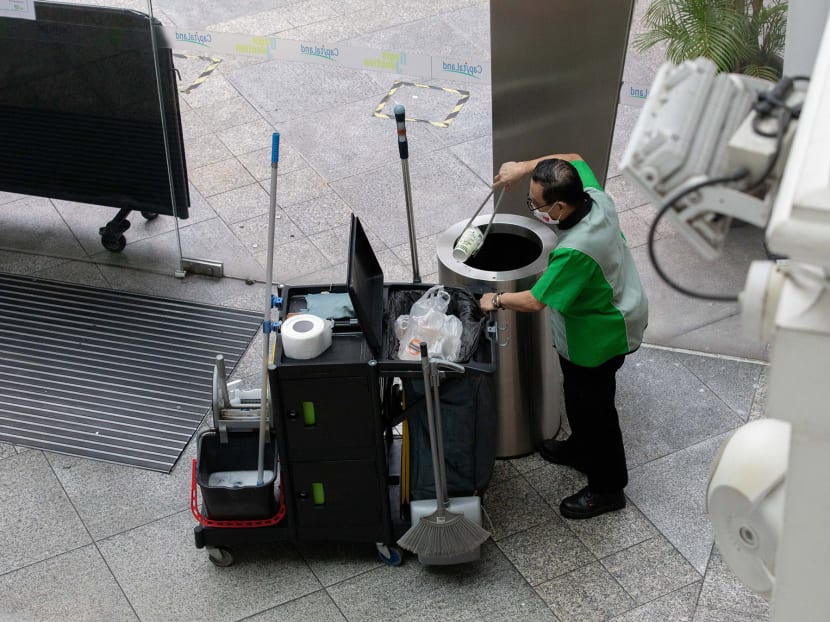National Wages Council calls for monthly pay increase of at least S$70 to S$90 for lower-wage workers
SINGAPORE — The National Wages Council (NWC) has recommended that employers of workers earning a gross monthly wage of up to S$2,000 provide a built-in wage rise of 4.5 to 7.5 per cent of gross wages, or S$70 to S$90, whichever is higher. This is the first time that the council has put forward a range for this group.

For the first time, the National Wages Council has recommended a range of progressive wage growth for lower-wage workers.
- The National Wages Council has recommended a range of progressive wage growth for lower-wage workers
- NTUC said the council's guidelines are “important to narrow the gap” between salaries of lower-wage workers and the median wage level over time
- The council will consider a higher range of progressive wage growth in 2022 should the economic situation improve
- It also issued a set of guidelines for all employers in relation to measures take to address the impact of Covid-19
SINGAPORE — The National Wages Council (NWC) has recommended that employers of workers earning a gross monthly wage of up to S$2,000 provide a built-in wage rise of 4.5 to 7.5 per cent of gross wages, or S$70 to S$90, whichever is higher. This is the first time that the council has put forward a range for this group.
The aim is to ensure that the pay received by lower-wage workers grows faster than the median wage level, the council said on Friday (Oct 29).
In a statement on the same day, the National Trades Union Congress (NTUC) said that the higher quantum of increases suggested by NWC is “important to narrow the gap” between the salaries of lower-wage workers and the median wage level over time.
Commenting on NWC's guidelines, Dr Tan See Leng, Minister for Manpower and Second Minister for Trade and Industry, said that this is the first time the council has recommended a range of progressive wage growth for lower-wage workers.
And “with things looking up for the economy and our labour market”, he encouraged employers to refer to the guidelines, which he said can help shape the development of business and the workforce.
NWC said that as this is the first year of implementation and there is need for lower-wage workers to “gain more ground with the median worker”, it will consider a higher range of progressive wage growth next year should the economic situation improve.
The council had convened in September to discuss the wage guidelines, which will cover the period of Dec 1 this year until Nov 30 next year.
The NWC's recommendations have been accepted by the tripartite partners: NTUC, the Singapore National Employers Federation (SNEF) and the Government.
Mr Aubeck Kam, permament secretary of the Ministry of Manpower (MOM), said during a press conference on the NWC's guidelines that the focus last year was on helping employers implement necessary wage cuts and appropriate cost-saving measures to save jobs.
“With the economy and the labour market gradually recovering, the tripartite partners agree that it is timely to ease the exceptional wage policies that were put in place earlier,” he said.
At the same time, he noted that the guidelines take into account the sectors and companies that continue to be adversely affected by Covid-19.
The council said that employers who are doing well and have experienced healthy revenue growth, even during the Covid-19 pandemic, should aim for the upper level of the progressive wage growth range.
Employers who are recovering, or have recovered from the impact of Covid-19, may aim for the lower to middle of the range.
“At the same time, the NWC recognises that there are some sectors or employers still facing economic headwinds whose business have not recovered,” it said.
For these employers, the council said that they should consider two points if they are continuing to freeze or reduce the wages of employees earning a gross monthly wage of up to S$2,000.
First, they should consider a built-in wage increase of up to S$50 instead, if they are either considering or continuing to freeze the wages of these workers.
Second, rather than reduce wages further, they should consider freezing the wages instead.
RESTORE WAGE CUTS, EMPHASISE TRAINING
NWC's guidelines for employers across the board varied according to how much they continued to be affected by the pandemic.
Employers who have recovered or are recovering from the impact of Covid-19 should, in order of priority:
-
Restore wage cuts implemented earlier. Fixed wage components should be restored first, followed by variable wage components
-
Roll back wage-related cost-saving measures such as shorter work weeks
-
Grant built-in wage increases and variable payments
-
Roll back discretionary cost-saving measures such as cuts in allowances
Employers who continue to be adversely affected by Covid-19 should:
-
Tap government support measures to accelerate business and workforce transformation
-
Consider non-wage cost-saving measures and endeavour to pay the annual wage supplement
-
Implement temporary wage cuts to minimise retrenchments if the above measures have been exhausted
NWC also called on all employers who have not yet done so to implement the flexible wage system — which entails introducing a monthly variable component on top of an annual variable component.
The council said that the sharp impact of Covid-19 has “underscored the need for resilience and wage flexibility”, which the flexible wage system provides.
Mr Kam noted that only about 31.4 per cent of employees had it as part of their wage structure last year— though it was a slight improvement from 2019’s 29.1 per cent
“We are not satisfied, and there’s a lot more scope for more pervasive adoption,” he said.
In its guidelines, NWC also said that it is concerned about the proportion of employers who provided structured training to employees, which fell from 79.1 per cent in 2019 to 65.4 per cent in 2020.
The proportion of employees receiving structured training similarly dipped from 55.8 per cent in 2019 to 46.5 per cent in 2020.
The council thus called on the tripartite partners to “take decisive steps to transform jobs and upskill the workforce” by increasing the focus on training.
In a statement on Friday, SNEF said that the fall in training, as reflected in the statistics, may have been a result of the tight infection controls implemented last year, which reduced training capacity and “hindered employers” in sending their staff members for training.
However, it agreed with NWC’s sentiments and said that as the economy starts to reopen, “employers should step up in training their employees to be ready for economic recovery and growth”.








